Conservation Priorities in Terrestrial Protected Areas for Latin America and the Caribbean Based on an Ecoregional Analysis of Woody Vegetation Change, 2001–2010
Abstract
:1. Introduction
- (1)
- To summarize the coverage of TPAs in LAC at biome and finer-scale ecoregion levels.
- (2)
- To summarize the 2001 and 2010 extent of woody vegetation in LAC biomes and ecoregions within and outside of TPAs and compare changes of woody vegetation in this period.
- (3)
- To estimate and analyze the changes in conservation “risk” among ecoregions with woody cover based on rates of woody cover change and TPAs.
- (4)
- To discuss regional trends in relation to published global conservation priorities.
2. Materials and Methods
2.1. Study Area
2.2. Terrestrial Protected Areas Analysis
2.3. Ecoregion-Level Analysis of Woody Vegetation Change within and outside of TPAs
2.4. Calculation of the Woody Conservation Risk Index (WCRI)
2.5. Analyses of Trends in Relation to Existing Conservation Priorities
3. Results
3.1. TPAs in Biomes and Ecoregions
3.2. Analysis of Woody Vegetation Change within and outside of TPAs
3.2.1. Biome-Level Woody Vegetation and TPAs for the Year 2010
3.2.2. Ecoregion-Level Woody Vegetation Change within and outside of TPAs
3.3. Changes in the Woody Conservation Risk Index (WCRI)
3.4. Trends in Relation to Existing Conservation Priorities
4. Discussion
4.1. TPAs in LAC Biomes and Ecoregions: Comparison of Regional and Global Assessments of TPAs
4.2. Woody Vegetation Change in Biomes and Ecoregions between 2001 and 2010, within and outside of TPAs
4.3. Changes in the Woody Conservation Risk Index (WCRI)
4.4. Trends in Relation to Existing Conservation Priorities
5. Conclusions
Supplementary Materials
Author Contributions
Funding
Data Availability Statement
Acknowledgments
Conflicts of Interest
References
- Olson, D.M.; Graham, D.J.; Webster, A.L.; Primm, S.A.; Bookbinder, M.P.; Ledec, G. A Conservation Assessment of the Terrestrial Ecoregions of Latin America and the Caribbean. The World Bank: Washington, DC, USA, 1995; p. 157. [Google Scholar]
- Aukema, J.E.; Pricope, N.G.; Husak, G.J.; López-Carr, D. Biodiversity Areas under Threat: Overlap of Climate Change and Population Pressures on the World’s Biodiversity Priorities. PLoS ONE 2017, 12, e0170615. [Google Scholar] [CrossRef]
- Myers, N.; Mittermeier, R.A.; Mittermeier, C.G.; Da Fonseca, G.A.B.; Kent, J. Biodiversity hotspots for conservation priorities. Nature 2000, 403, 853–858. [Google Scholar] [CrossRef]
- Pereira, H.M.; Navarro, L.M.; Martins, I.S. Global biodiversity change: The bag, the good and the unknown. Annu. Rev. Environ. Resour. 2012, 37, 25–50. [Google Scholar] [CrossRef] [Green Version]
- Hoekstra, J.M.; Boucher, T.M.; Ricketts, T.H.; Roberts, C. Confronting a biome crisis: Global disparities of habitat loss and protection. Ecol. Lett. 2004, 8, 23–29. [Google Scholar] [CrossRef]
- Andam, K.S.; Ferraro, P.S.; Hanauer, M.M. The effects of protected area systems on ecosystem restoration: A quasi-experimental design to estimate the impact of Costa Rica’s protected area system on forest regrowth. Conserv. Lett. 2013, 6, 317–323. [Google Scholar] [CrossRef]
- Carr, D.L. Farm Households and Land Use in a Core Conservation Zone of the Maya Biosphere Reserve, Guatemala. Hum. Ecol. 2008, 36, 231–248. [Google Scholar] [CrossRef]
- Carr, D.L.; Lopez, A.C.; Bilsborrow, R.E. The population, agriculture, and environment nexus in Latin America: Coun-try-level evidence from the latter half of the twentieth century. Popul. Environ. 2009, 30, 222–246. [Google Scholar] [CrossRef]
- Painter, M. Social Change and Applied Anthropology; Taylor & Francis Group: London, UK, 1990; Development and Conservation of Natural Resources in Latin America. [Google Scholar] [CrossRef]
- Rocha, J.C.; Baraibar, M.M.; Deutsch, L.; De Bremond, A.; Oestreicher, J.S.; Rositano, F.; Gelabert, C.C. Toward understanding the dynamics of land change in Latin America: Potential utility of a resilience approach for building archetypes of land-systems change. Ecol. Soc. 2019, 24, 17. [Google Scholar] [CrossRef]
- Seymour, F.; Harris, N.L. Reducing tropical deforestation. Science 2019, 365, 756–757. [Google Scholar] [CrossRef] [Green Version]
- Armenteras, D.; Espelta, J.M.; Rodríguez, N.; Retana, J. Deforestation dynamics and drivers in different forest types in Latin America: Three decades of studies (1980–2010). Glob. Environ. Chang. 2017, 46, 139–147. [Google Scholar] [CrossRef]
- Blackman, A.; Epanchin-Niell, R.; Siikamäki, J.; Velez-Lopez, D. Biodiversity Conservation in Latin America and the Caribbean; Taylor & Francis Group: London, UK, 2014. [Google Scholar] [CrossRef]
- Ceddia, M.G. The impact of income, land, and wealth inequality on agricultural expansion in Latin America. Proc. Natl. Acad. Sci. USA 2019, 116, 2527–2532. [Google Scholar] [CrossRef] [Green Version]
- Poorter, L.; Bongers, F.; Aide, T.M.; Zambrano, A.M.A.; Balvanera, P.; Becknell, J.M.; Boukili, V.; Brancalion, P.H.; Broadbent, E.N.; Chazdon, R.L.; et al. Biomass resilience of tropical secondary forests. Nature 2016, 530, 211–214. [Google Scholar] [CrossRef] [PubMed]
- Chazdon, R.L.; Broadbent, E.N.; Rozendaal, D.M.A.; Bongers, F.; Zambrano, A.M.A.; Aide, T.M.; Balvanera, P.; Becknell, J.M.; Boukili, V.; Brancalion, P.H.S.; et al. Carbon sequestration potential of second-growth forest regeneration in the Latin American tropics. Sci. Adv. 2016, 2, e1501639. [Google Scholar] [CrossRef] [PubMed] [Green Version]
- Pack, S.M.; Ferreira, M.N.; Krithivasan, R.; Murrow, J.; Bernard, E.; Mascia, M.B. Protected area downgrading, downsizing, and degazettement (PADDD) in the Amazon. Biol. Conserv. 2016, 197, 32–39. [Google Scholar] [CrossRef]
- Nolte, C.; Agrawal, A.; Silvius, K.; Soares-Filho, B.A. Governance regime and location influence avoided deforestation suc-cess of protected areas in the Brazilian Amazon. Proc. Natl. Acad. Sci. USA 2013, 110, 4956–4961. [Google Scholar] [CrossRef] [Green Version]
- Bruner, A.G.; Gullison, R.E.; Rice, R.E.; Da Fonseca, G.A.B. Effectiveness of Parks in Protecting Tropical Biodiversity. Science 2001, 291, 125–128. [Google Scholar] [CrossRef] [Green Version]
- Leroux, S.J.; Krawchuk, M.A.; Schmiegelow, F.; Cumming, S.G.; Lisgo, K.; Anderson, L.G.; Petkova, M. Global protected ar-eas and IUCN designations: Do the categories match the conditions? Biol. Conserv. 2010, 143, 609–616. [Google Scholar] [CrossRef]
- Leverington, F.; Costa, K.L.; Pavese, H.; Lisle, A.; Hockings, M. A global analysis of protected area management effective-ness. J. Environ. Manag. 2010, 46, 685–698. [Google Scholar] [CrossRef]
- Locke, H.; Dearden, P. Rethinking protected area categories and the new paradigm. Environ. Conserv. 2005, 32, 1–10. [Google Scholar] [CrossRef]
- Rodrigues, A.S.L.; Andelman, S.J.; Bakarr, M.I.; Boitani, L.; Brooks, T.; Cowling, R.M.; Fishpool, L.D.C.; Da Fonseca, G.A.B.; Gaston, K.J.; Hoffmann, M.; et al. Effectiveness of the global protected area network in representing species diversity. Nature 2004, 428, 640–643. [Google Scholar] [CrossRef]
- Liu, J.; Hull, V.; Batistella, M.; DeFries, R.; Dietz, T.; Fu, F.; Hertel, T.W.; Izaurralde, R.C.; Lambin, E.F.; Li, S.; et al. Framing Sustainability in a Telecoupled World. Ecol. Soc. 2013, 18. [Google Scholar] [CrossRef]
- Whittaker, R.J.; Araújo, M.B.; Jepson, P.R.; Ladle, R.; Watson, J.; Willis, K. Conservation Biogeography: Assessment and prospect. Divers. Distrib. 2005, 11, 3–23. [Google Scholar] [CrossRef]
- Grau, H.R.; Gasparri, N.I.; Aide, T.M. Balancing food production and nature conservation in the Neotropical dry forests of northern Argentina. Glob. Chang. Biol. 2008, 14, 985–997. [Google Scholar] [CrossRef]
- Soares-Filho, B.; Moutinho, P.; Nepstad, D.; Anderson, A.; Rodrigues, H.; Garcia, R.; Dietzsch, L.; Merry, F.; Bowman, M.; Hissa, L.; et al. Role of Brazilian Amazon protected areas in climate change mitigation. Proc. Natl. Acad. Sci. USA 2010, 107, 10821–10826. [Google Scholar] [CrossRef] [PubMed] [Green Version]
- Aide, T.M.; Clark, M.L.; Grau, H.R.; López-Carr, D.; Levy, M.; Redo, D.; Bonilla-Moheno, M.; Riner, G.; Andrade-Núñez, M.J.; Muñiz, M. Deforestation and Reforestation of Latin America and the Caribbean (2001-2010). Biotropica 2012, 45, 262–271. [Google Scholar] [CrossRef]
- Redo, D.; Grau, H.R.; Aide, T.M.; Clark, M. Asymmetric forest transition driven by the interaction of socioeconomic development and environmental heterogeneity in Central America. Proc. Natl. Acad. Sci. USA 2012, 23, 8839–8844. [Google Scholar] [CrossRef] [Green Version]
- Wright, S.J. The future of tropical forests. Ann. N. Y. Acad. Sci. 2010, 1995, 1–27. [Google Scholar]
- Loyola, R.D.; Kubota, U.; da Fonseca, G.A.B.; Lewinsohn, T.M. Key Neotropical ecoregions for conservation of terrestrial vertebrates. Biodivers. Conserv. 2009, 18, 2017–2031. [Google Scholar] [CrossRef]
- Olson, D.M.; Dinerstein, E.; Wikramanayake, E.D.; Burgess, N.D.; Powell, G.V.; Underwood, E.C.; D’amico, J.A.; Itoua, I.; Strand, H.E.; Morrison, J.C.; et al. Terrestrial ecoregions of the worlds: A new map of life on Earth. Bioscience 2001, 51, 933–938. [Google Scholar] [CrossRef]
- Nelson, A.; Chomitz, K.M. Effectiveness of Strict vs. Multiple Use Protected Areas in Reducing Tropical Forest Fires: A Global Analysis Using Matching Methods. PLoS ONE 2011, 6, e22722. [Google Scholar] [CrossRef]
- IUCN, UNEP-WCMC. The World Database on Protected Areas (WDPA) [On-line]. UNEP-WCMC: Cambridge, UK, 2012; Available online: www.protectedplanet.net (accessed on 31 October 2012).
- Clark, M.L.; Aide, T.M.; Riner, G. Land change for all municipalities in Latin America and the Caribbean assessed from 250-m MODIS imagery (2001–2010). Remote Sens. Environ. 2012, 126, 84–103. [Google Scholar] [CrossRef]
- Breiman, L. Random forests. Mach. Learn. 2001, 45, 5–32. [Google Scholar] [CrossRef] [Green Version]
- Soutullo, A.; De Castro, M.; Urios, V. Linking political and scientifically derived targets for global biodiversity conservation: Implications for the expansion of the global network of protected areas. Divers. Distrib. 2008, 14, 604–613. [Google Scholar] [CrossRef]
- Mittermeier, R.A.; Mittermeier, C.G.; Brooks, T.M.; Pilgrim, J.D.; Konstant, W.R.; Da Fonseca, G.A.; Kormos, C. Wilderness and biodiversity conservation. Proc. Natl. Acad. Sci. USA 2003, 100, 10309–10313. [Google Scholar] [CrossRef] [Green Version]
- Olson, D.M.; Dinerstein, E. The Global 200: A Representation Approach to Conserving the Earth's Most Biologically Valuable Ecoregions. Conserv. Biol. 1998, 12, 502–515. [Google Scholar] [CrossRef] [Green Version]
- Sanderson, E.W.; Jaiteh, M.; Levy, M.A.; Redford, K.H.; Wannebo, A.V.; Woolmer, G. The human footprint and the last of the wild: The human footprint is a global map of human influence on the land surface, which suggests that human beings are stewards of nature, whether we like it or not. BioScience 2002, 52, 891–904. [Google Scholar] [CrossRef]
- Brooks, T.M.; Mittermeier, R.A.; Da Fonseca, G.A.B.; Gerlach, J.; Hoffmann, M.; Lamoreux, J.F.; Mittermeier, C.G.; Pilgrim, J.D.; Rodrigues, A. Global Biodiversity Conservation Priorities. Science 2006, 313, 58–61. [Google Scholar] [CrossRef] [Green Version]
- Jenkins, C.; Joppa, L. Expansion of the global terrestrial protected area system. Biol. Conserv. 2009, 142, 2166–2174. [Google Scholar] [CrossRef]
- Fearnside, P.M. Deforestation soars in the Amazon. Nature 2015, 521, 423. [Google Scholar] [CrossRef] [PubMed] [Green Version]
- Gibbs, H.K.; Munger, J.; L’Roe, J.; Barreto, P.; Pereira, R.; Christie, M.; Amaral, T.; Walker, N.F. Did ranchers and slaughter-houses respond to zero-deforestation agreements in the Brazilian Amazon? Conserv. Lett. 2016, 9, 32–42. [Google Scholar] [CrossRef]
- Cabral, A.I.; Saito, C.; Pereira, H.; Laques, A.E. Deforestation pattern dynamics in protected areas of the Brazilian Legal Amazon using remote sensing data. Appl. Geogr. 2018, 100, 101–115. [Google Scholar] [CrossRef]
- Nepstad, D.; Schwartzman, S.; Bamberger, B.; Santilli, M.; Ray, D.; Schlesinger, P.; Lefebvre, P.; Alencar, A.; Prinz, E.; Fiske, G.; et al. Inhibition of Amazon Deforestation and Fire by Parks and Indigenous Lands. Conserv. Biol. 2006, 20, 65–73. [Google Scholar] [CrossRef]
- Adeney, J.M.; Christensen, N.L.; Pimm, S.L. Reserves Protect against Deforestation Fires in the Amazon. PLoS ONE 2009, 4, e5014. [Google Scholar] [CrossRef] [PubMed]
- European Commission, Joint Research Centre. Global Land Cover 2000 database, 2003. Available online: http://bioval.jrc.ec.europa.eu/products/glc2000/glc2000.php (accessed on 3 October 2021).
- Chowdhury, R.R. Landscape change in the Calakmul Biosphere Reserve: Modeling driving forces of smallholder deforestation in land parcels. Appl. Geogr. 2006, 26, 129–152. [Google Scholar] [CrossRef]
- Lambin, E.; Gibbs, H.; Ferreira, L.; Grau, R.; Mayaux, P.; Meyfroidt, P.; Morton, D.; Rudel, T.; Gasparri, N.I.; Munger, J. Estimating the world's potentially available cropland using a bottom-up approach. Glob. Environ. Chang. 2013, 23, 892–901. [Google Scholar] [CrossRef]
- Sanchez-Azofeifa, A.; Harriss, R.C.; Skole, D.L. Deforestation in Costa Rica: A quantitative analysis using remote sensing imagery. Biotropica 2001, 33, 378–384. [Google Scholar] [CrossRef]
- Southworth, J.; Tucker, C. The Influence of Accessibility, Local Institutions, and Socioeconomic Factors on Forest Cover Change in the Mountains of Western Honduras. Mt. Res. Dev. 2001, 21, 276–283. [Google Scholar] [CrossRef] [Green Version]
- Álvarez-Berríos, N.L.; Redo, D.J.; Aide, T.M.; Clark, M.L.; Grau, R. Land Change in the Greater Antilles between 2001 and 2010. Land 2013, 2, 81–107. [Google Scholar] [CrossRef] [Green Version]
- Graesser, J.; Aide, T.M.; Grau, H.R.; Ramankutty, N. Cropland/pastureland dynamics and the slowdown of deforestation in Latin America. Environ. Res. Lett. 2015, 10. [Google Scholar] [CrossRef]
- Bonilla-Moheno, M.; Aide, T.M.; Clark, M. The influence of socioeconomic, environmental and demographic factors on mu-nicipality-scale land cover change in Mexico. Reg. Environ. Chang. 2012, 12, 543–557. [Google Scholar] [CrossRef]
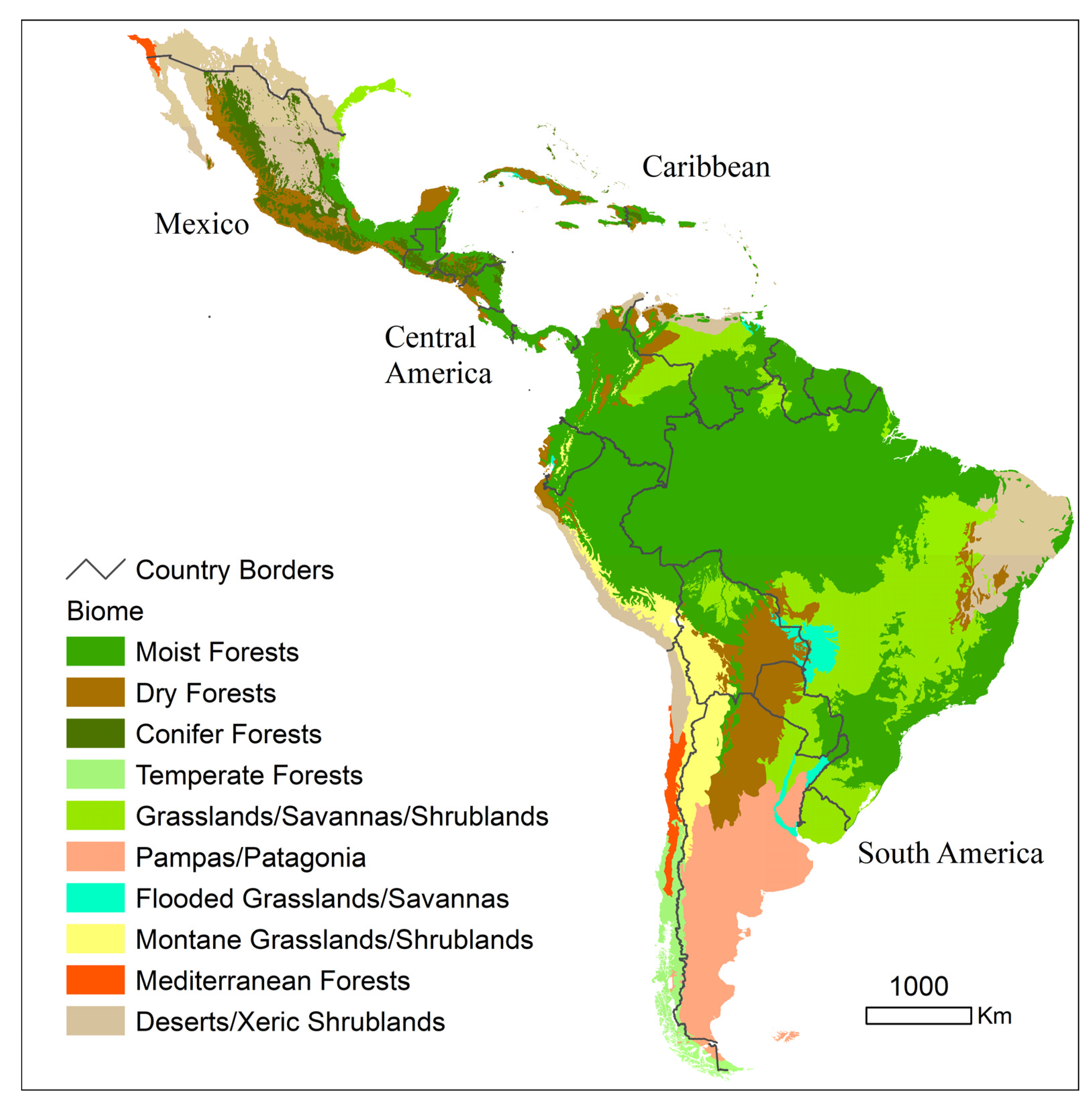

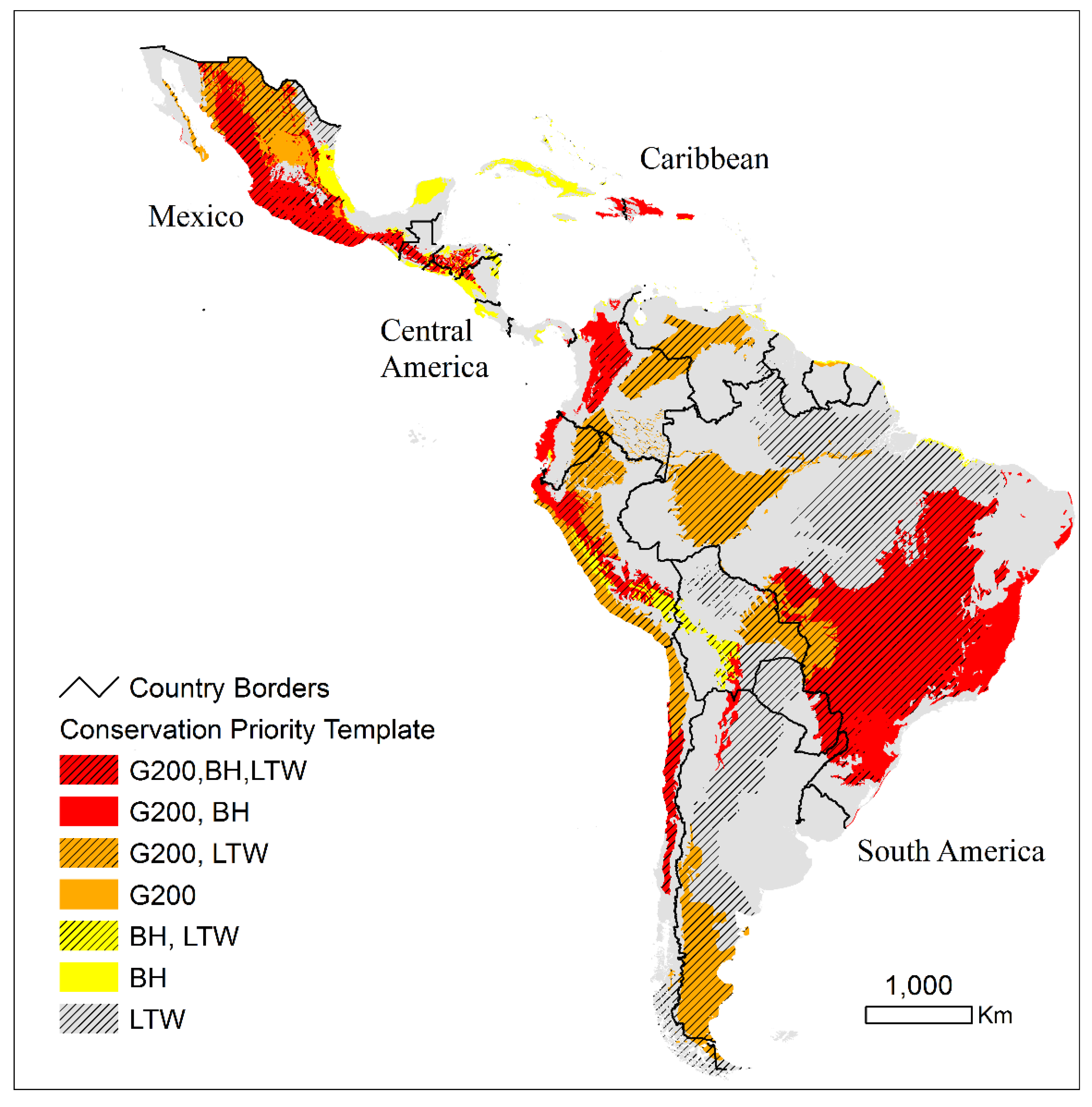
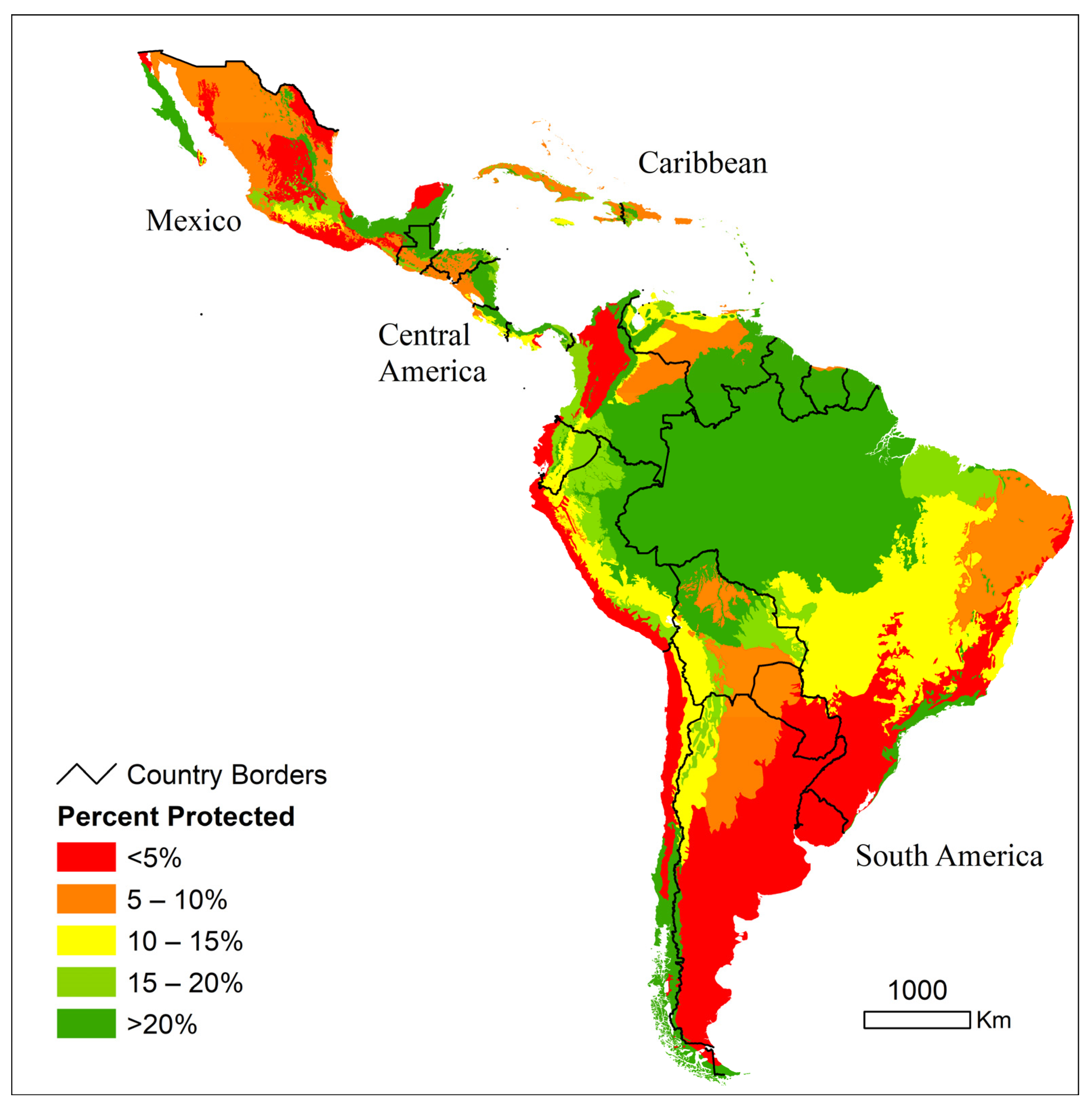
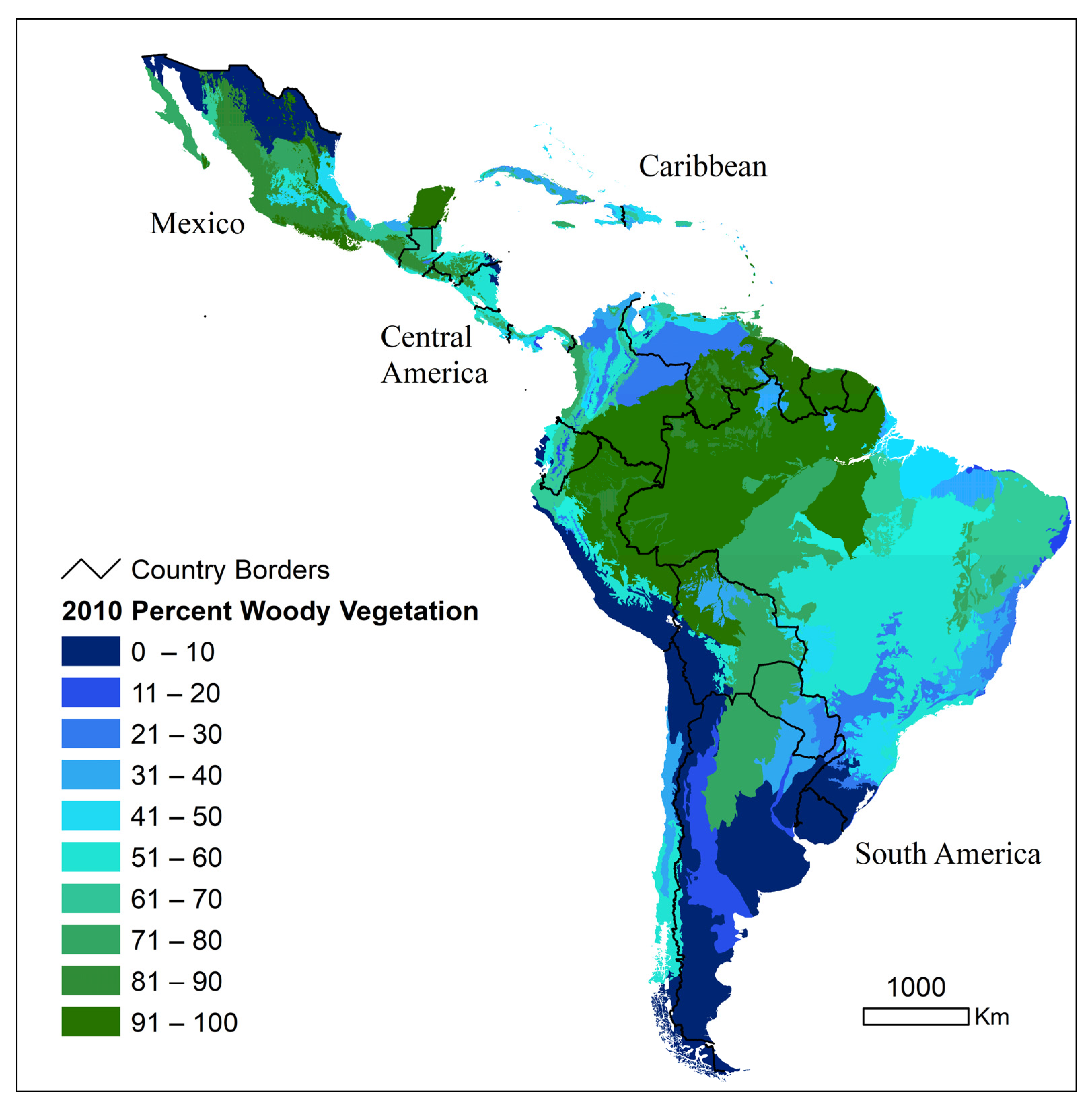

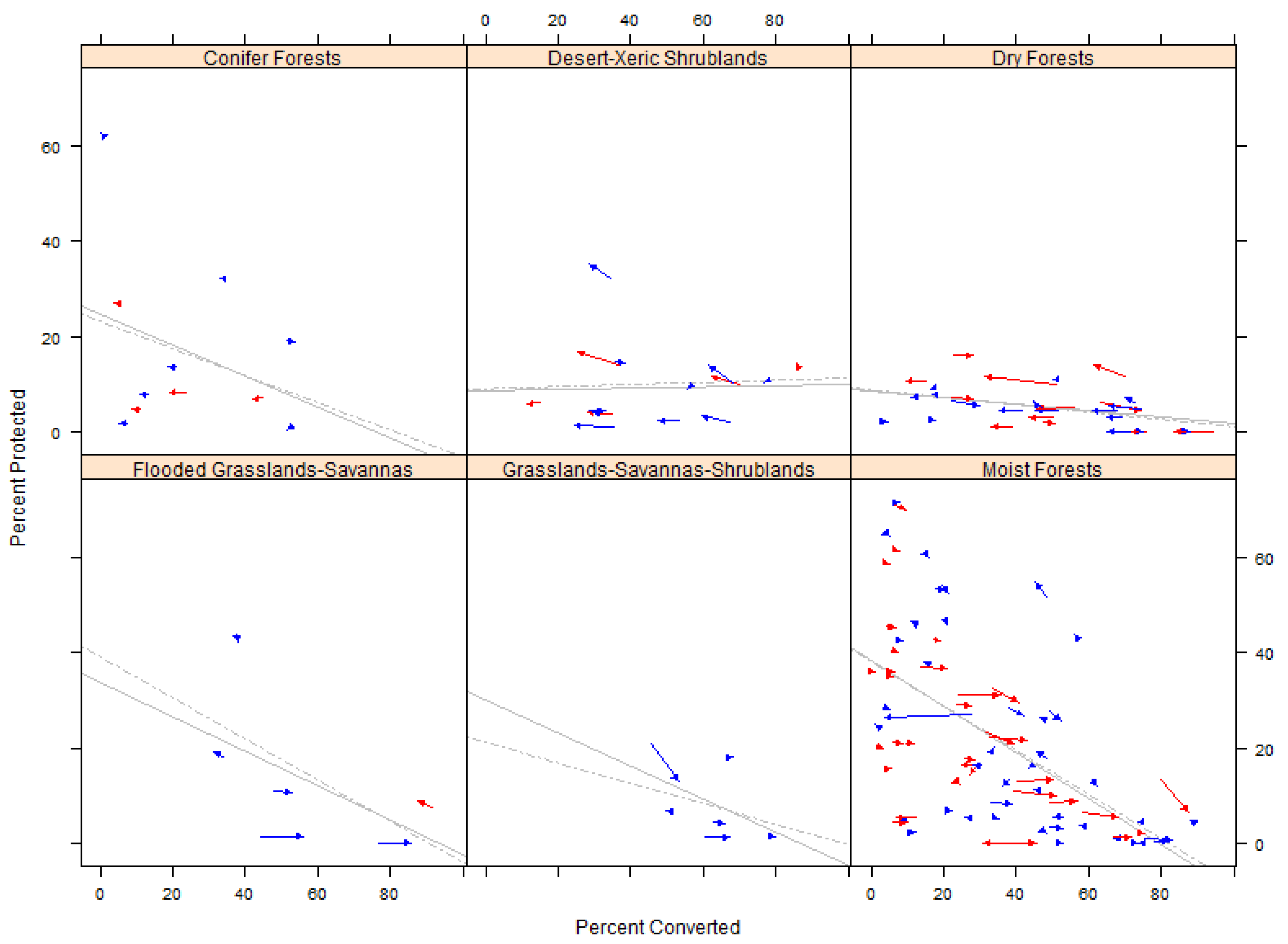

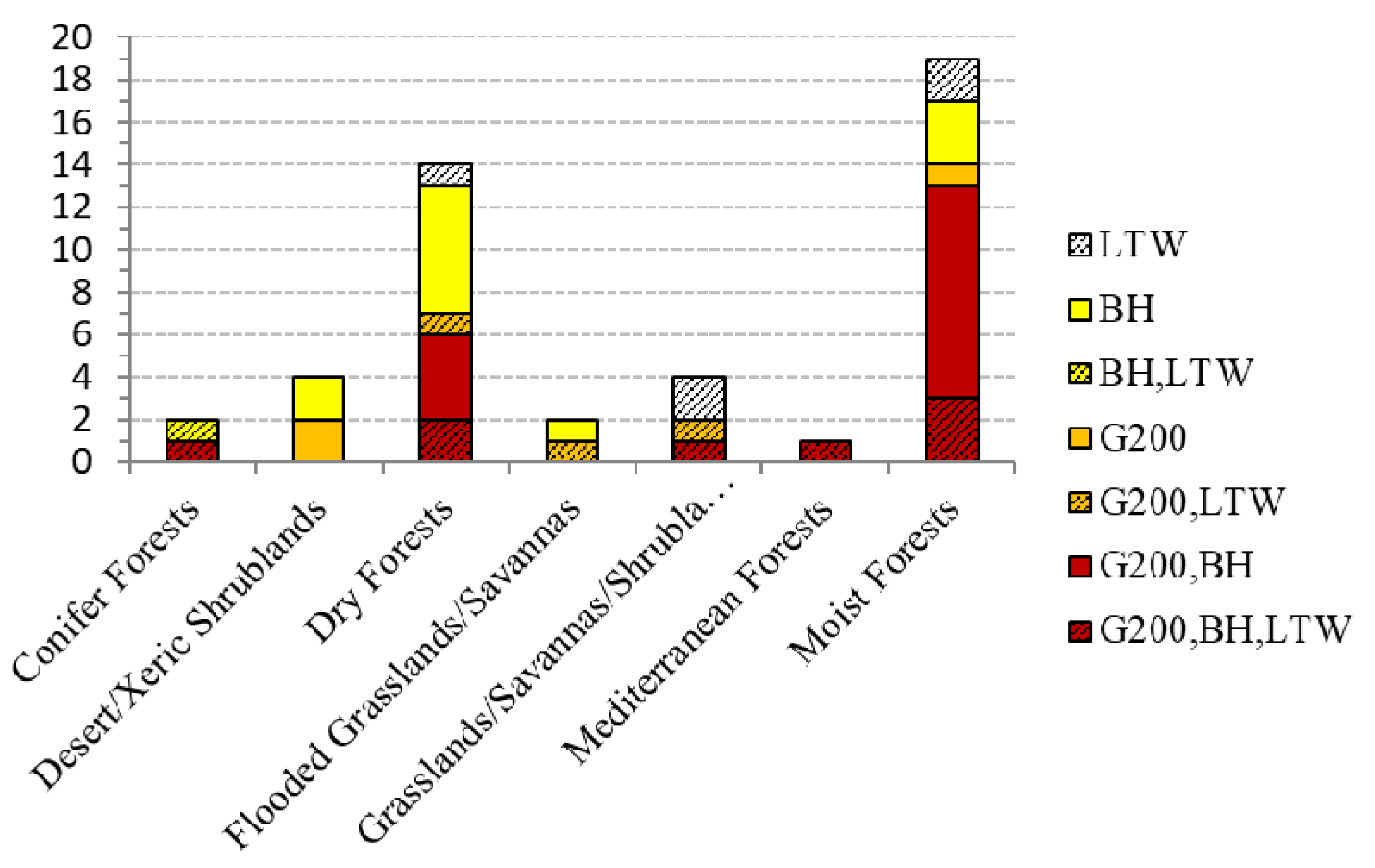

| Biome Short Name | Biome Name | Number of Ecoregions | Area (km2) | Percentage of Total Area |
|---|---|---|---|---|
| Moist Forests | Tropical & Subtropical Moist Broadleaf Forests | 78 | 9,275,404 | 44.5 |
| Dry Forests | Tropical & Subtropical Dry Broadleaf Forests | 31 | 1,985,203 | 9.5 |
| Conifer Forests | Tropical & Subtropical Coniferous Forests | 12 | 605,947 | 2.9 |
| Temperate Forests | Temperate Broadleaf & Mixed Forests | 2 | 412,763 | 2.0 |
| Grasslands/Savannas/Shrublands | Tropical & Subtropical Grasslands, Savannas, Shrublands | 8 | 3,274,021 | 15.7 |
| Pampas/Patagonia | Temperate Grasslands, Savannas & Shrublands | 4 | 1,629,672 | 7.8 |
| Flooded Grasslands/Savannas | Flooded Grasslands & Savannas | 7 | 250,879 | 1.2 |
| Montane Grasslands/Shrublands | Montane Grasslands & Shrublands | 9 | 874,700 | 0.04 |
| Mediterranean Forests | Mediterranean Forests, Woodlands, and Scrub | 2 | 183,585 | 0.9 |
| Desert/Xeric Shrublands | Deserts & Xeric Shrublands | 20 | 2,346,676 | 11.5 |
| All biomes | 173 | 20,838,849 | 100.0 |
| Biome Name | Total Area km2 | Area Covered by TPAs km2 | % of Area Protected |
|---|---|---|---|
| Moist Forests | 9,275,404 | 3,043,917 | 32.8 |
| Dry Forests | 1,985,203 | 164,795 | 8.3 |
| Conifer Forests | 605,947 | 72,342 | 11.9 |
| Temperate Forests | 412,763 | 133,844 | 32.4 |
| Grasslands/Savannas/Shrublands | 3,274,021 | 353,567 | 10.8 |
| Pampas/Patagonia | 1,629,672 | 32,952 | 2.0 |
| Flooded Grasslands/Savannas | 250,879 | 31,192 | 12.4 |
| Montane Grasslands/Shrublands | 874,700 | 117,734 | 13.5 |
| Mediterranean Forests | 183,585 | 1472 | 0.8 |
| Desert/Xeric Shrublands | 2,346,676 | 177,881 | 7.6 |
| All biomes | 20,838,849 | 4,129,697 | 19.8 |
| Biome Short Name | Biome Name | Number of Ecoregions | Number of Ecoregions with ≥10% of Area with TPAs | Percentage of Ecoregions with ≥10% of Area with TPAs |
|---|---|---|---|---|
| Moist Forests | Tropical & Subtropical Moist Broadleaf Forests | 78 | 59 | 75.6 |
| Dry Forests | Tropical & Subtropical Dry Broadleaf Forests | 31 | 8 | 25.8 |
| Conifer Forests | Tropical & Subtropical Coniferous Forests | 12 | 6 | 50.0 |
| Temperate Forests | Temperate Broadleaf & Mixed Forests | 2 | 2 | 100.0 |
| Grasslands/Savannas/Shrublands | Tropical & Subtropical Grasslands, Savannas, Shrublands | 8 | 3 | 37.5 |
| Pampas/Patagonia | Temperate Grasslands, Savannas & Shrublands | 4 | 0 | 0.0 |
| Flooded Grasslands/Savannas | Flooded Grasslands & Savannas | 7 | 4 | 57.1 |
| Montane Grasslands/Shrublands | Montane Grasslands & Shrublands | 9 | 8 | 88.9 |
| Mediterranean Forests | Mediterranean Forests, Woodlands, and Scrub | 2 | 0 | 0.0 |
| Desert/Xeric Shrublands | Deserts & Xeric Shrublands | 20 | 9 | 45.0 |
| All biomes | 173 | 99 | 57.2 |
| Biome | Woody Area 2001 | Woody Area 2010 | Woody Change % |
|---|---|---|---|
| Moist Forests | 7,096,604 | 6,852,251 | −3.4 |
| Dry Forests | 1,336,891 | 1,362,995 | 2.0 |
| Conifer Forests | 492,670 | 507,498 | 3.0 |
| Temperate Forests | 145,849 | 145,559 | −0.2 |
| Grasslands/Savannas/Shrublands | 1,277,378 | 1,256,820 | −1.6 |
| Flooded Grasslands/Savannas | 108,763 | 96,620 | −11.2 |
| Mediterranean Forests | 43,316 | 45,845 | 5.8 |
| Desert/Xeric Shrublands | 786,539 | 772,470 | −1.8 |
| All biomes | 11,228,010 | 11,040,058 | −2.2 |
| Unprotected Woody Vegetation | Protected Woody Vegetation | ||||||
|---|---|---|---|---|---|---|---|
| Biome Name | Area 2001 | Area 2010 | Change % | Area 2001 | Area 2010 | Change % | Protected Woody Relative to 2010 Woody Area % |
| Moist Forests | 4,308,243 | 4,092,788 | −5.0 | 2,788,361 | 2,759,463 | −1.0 | 40.3 |
| Dry Forests | 1,194,896 | 1,224,460 | 2.5 | 141,995 | 138,535 | −2.4 | 10.2 |
| Conifer Forests | 429,397 | 443,754 | 3.3 | 63,273 | 63,744 | 0.7 | 12.6 |
| Temperate Forests | 101,501 | 101,878 | 0.4 | 44,348 | 43,681 | −1.5 | 30.0 |
| Grasslands/Savannas/Shrublands | 1,107,381 | 1,086,495 | −1.9 | 169,997 | 170,325 | 0.2 | 13.6 |
| Flooded Grasslands/Savannas | 86,219 | 75,030 | −13.0 | 22,544 | 21,590 | −4.2 | 22.3 |
| Mediterranean Forests | 42,677 | 45,180 | 5.9 | 639 | 665 | 4.1 | 1.5 |
| Desert/Xeric Shrublands | 705,667 | 687,340 | −2.6 | 80,872 | 85,130 | 5.3 | 11.0 |
| All biomes | 7,975,981 | 7,756,925 | −2.7 | 3,312,029 | 3,283,133 | −2.7 | 29.7 |
| Inside TPAs | Outside TPAs | |||||
|---|---|---|---|---|---|---|
| Biome Name | Gain | Loss | No Change | Gain | Loss | No Change |
| Moist Forests | 0 (0.0) | 15 (19.2) | 63 (80.8) | 3 (3.8) | 29 (37.2) | 46 (59.0) |
| Dry Forests | 3 (10.0) | 3 (10.0) | 24 (80.0) | 7 (23.3) | 3 (10.0) | 20 (66.7) |
| Conifer Forests | 2 (18.2) | 1 (9.1) | 8 (72.7) | 2 (18.2) | 0 (0.0) | 9 (81.8) |
| Temperate Forests | 0 (0.0) | 0 (0.0) | 1 (100.0) | 0 (0.0) | 0 (0.0) | 1 (100.0) |
| Grasslands/Savannas/Shrublands | 0 (0.0) | 0 (0.0) | 6 (100.0) | 0 (0.0) | 0 (0.0) | 6 (100.0) |
| Flooded Grasslands/Savannas | 1 (16.7) | 0 (0.0) | 5 (83.3) | 1 (16.7) | 0 (0.0) | 5 (83.3) |
| Mediterranean Forests | 0 (0.0) | 0 (0.0) | 1 (100.0) | 0 (0.0) | 0 (0.0) | 1 (100.0) |
| Desert/Xeric Shrublands | 1 (6.7) | 0 (0.0) | 14 (93.3) | 4 (26.7) | 0 (0.0) | 11 (73.3) |
| All biomes | 7 (4.7) | 19 (12.8) | 122 (82.4) | 17 (11.5) | 32 (21.6) | 99 (66.9) |
Publisher’s Note: MDPI stays neutral with regard to jurisdictional claims in published maps and institutional affiliations. |
© 2021 by the authors. Licensee MDPI, Basel, Switzerland. This article is an open access article distributed under the terms and conditions of the Creative Commons Attribution (CC BY) license (https://creativecommons.org/licenses/by/4.0/).
Share and Cite
Clark, M.L.; Ruiz, J.; Fandino, M.C.; López-Carr, D. Conservation Priorities in Terrestrial Protected Areas for Latin America and the Caribbean Based on an Ecoregional Analysis of Woody Vegetation Change, 2001–2010. Land 2021, 10, 1067. https://doi.org/10.3390/land10101067
Clark ML, Ruiz J, Fandino MC, López-Carr D. Conservation Priorities in Terrestrial Protected Areas for Latin America and the Caribbean Based on an Ecoregional Analysis of Woody Vegetation Change, 2001–2010. Land. 2021; 10(10):1067. https://doi.org/10.3390/land10101067
Chicago/Turabian StyleClark, Matthew L., Jorge Ruiz, Maria C. Fandino, and David López-Carr. 2021. "Conservation Priorities in Terrestrial Protected Areas for Latin America and the Caribbean Based on an Ecoregional Analysis of Woody Vegetation Change, 2001–2010" Land 10, no. 10: 1067. https://doi.org/10.3390/land10101067
APA StyleClark, M. L., Ruiz, J., Fandino, M. C., & López-Carr, D. (2021). Conservation Priorities in Terrestrial Protected Areas for Latin America and the Caribbean Based on an Ecoregional Analysis of Woody Vegetation Change, 2001–2010. Land, 10(10), 1067. https://doi.org/10.3390/land10101067






